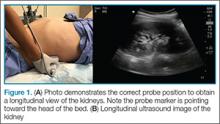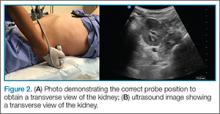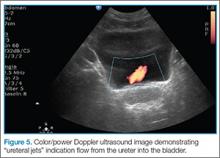Background
A recent multicenter trial by Smith-Bindman et al1 showed that ultrasound (point of care [POC] or radiology) should be considered as the first-line imaging test in evaluating patients with suspected renal colic. In addition to its ability to visualize significant renal hydronephrosis, POC ultrasound is also an excellent modality to assess for intrarenal stones.Technique
The study is performed with a curvilinear probe placed in the left and right midaxillary region along the lower costal margin. To obtain a longitudinal view of the kidneys, the probe marker should point toward the head of the bed (Figure 1). The clinician should then slide the probe until the kidney comes into view just caudal to either the liver on the right or the spleen on the left. It is important to remember that the kidneys are retroperitoneal; as such, the probe should be pointed toward the bed to ensure visualization.
The probe should be swept/fanned through the kidney so that the entire organ is visualized from cortex to renal calices. To obtain a transverse view of the kidney, the probe marker should be rotated 90˚ clockwise (Figure 2); the probe should also be swept/fanned through the kidney in this orientation as well. In addition, during evaluation, the bladder should also be scanned in both the longitudinal and transverse planes to assess its volume and the presence of stones.Hydronephrosis
Ureteral or bladder outlet obstruction can lead to unilateral or bilateral renal hydronephrosis, which can present on a spectrum ranging from mild to severe. As fluid appears black on ultrasound, hydronephrosis will appear black in what is normally an echogenic center of the kidney. The higher the degree of hydronephrosis, the larger the area of black; in cases of severe hydronephrosis, there is thinning of the renal parenchyma and most of the kidney is taken up by dilated calyces (Figure 3). If there is uncertainty during evaluation, color Doppler may be employed to differentiate the vascular renal hilum from hydronephrosis (Figure 4).
Ureteral Stones
Ureteral stones are not typically visualized by ultrasound. However, intrarenal stones can be found. These will appear as hyperechoic structures within the central area of the kidney with acoustic shadowing artifact noted underneath them. Additionally, while scanning the bladder, one can sometimes find a stone lodged in the ureteropelvic junction (UPJ). One can also look for “ureteral jets,” seen as periodic flow of urine within the bladder using color/power Doppler (Figure 5).
Pearls/Pitfalls
As abdominal aortic aneurysm (AAA) can mimic renal stones, it is important to scan the aorta in patients presenting with renal colic or flank pain who are at increased risk for AAA or who are older than age 50 years. In addition, during evaluation, the clinician should keep in mind that pregnancy state and aggressive intravenous fluid administration can lead to mild bilateral hydronephrosis. In addition, incidental renal cysts/masses are often encountered during imaging and require close follow-up (Figure 6).Dr Meer is an assistant professor and director of emergency ultrasound, department of emergency medicine, Emory University School of Medicine, Atlanta, Georgia. Dr Beck is an assistant professor, department of emergency medicine, Emory University School of Medicine, Atlanta, Georgia. Dr Taylor is an assistant professor and director of postgraduate medical education, department of emergency medicine, Emory University School of Medicine, Atlanta, Georgia.






